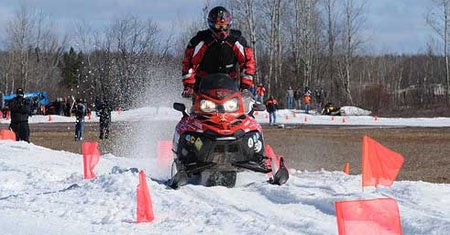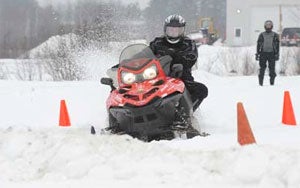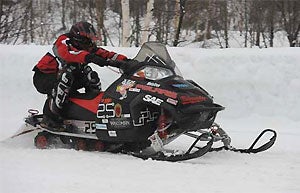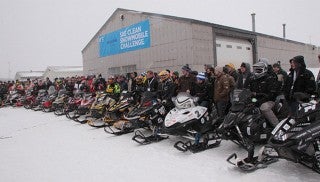UW-Madison wins Clean Snowmobile Challenge

Team wins both classes with Polaris snowmobiles
For the second year in a row, Polaris snowmobiles and the University of Wisconsin-Madison formed a winning team as the Badgers took first place in both classes at the 2010 SAE Clean Snowmobile Challenge. It was the second straight year the school won both titles.
The Polaris snowmobiles entered by the UW-Madison engineering students took top honors in both the internal combustion division and the zero-emissions division in competition held in late March at Michigan Technological University in Houghton, Mich. The UW-Madison team was the only group to enter a sled in each division in the 2010 event.
Polaris provides technical support and resources to several teams to encourage research and development by engineering students who might create the sleds of tomorrow once they graduate and enter the workforce with manufacturers such as Polaris.
In the Clean Snowmobile Challenge, engineering students from colleges and universities across the snowbelt re-engineer snowmobiles to produce minimal emissions and operating sound while maintaining or improving performance. Along with fuel efficiency and exhaust cleanliness, each sled is judged on aspects of its performance such as handling and acceleration.
 University of Wisconsin-Madison swept the titles at the 2010 SAE Clean Snowmobile Challenge.
University of Wisconsin-Madison swept the titles at the 2010 SAE Clean Snowmobile Challenge.Unseasonably warm weather melted nearly all of the snow in the Houghton area, and event planners used front end loaders to built test tracks for the event. Test-day temperatures above 60 degrees F also tested sled reliability.
“It came down to having a running sled the whole time,” UW-Madison team captain Jacob Mauermann said. “The warm weather made it difficult for everyone, so at the end of the day, it was about reliability as much as design.”
Best in Internal Combustion Division
 The Bucky 750 Clean-Fuel Sled is built on a 2007 Polaris FST LX chassis.
The Bucky 750 Clean-Fuel Sled is built on a 2007 Polaris FST LX chassis.In the internal combustion division, sponsored by the International Snowmobile Manufacturers Association (ISMA), the UW-Madison team used an ethanol-blended flex fuel in the Polaris snowmobile dubbed the “Bucky 750 Clean-Fuel Sled.”
This entry set a new record for exhaust cleanliness, showing emission levels more than 15 times cleaner than those of the runner-up. The specially blended fuel used ethanol from the United Wisconsin Grain Producers. Using a special ECM (engine control module) and software, the sled was capable of automatically adjusting to use any blend of ethanol and produce practically no exhaust emissions.
Dr. Glenn Bower, the Madison team’s advisor, said the winning internal combustion sled was a 2007 Polaris FST LX chassis equipped with a turbo-charged 750cc engine equipped with a custom engine control system.
Along with winning top overall honors, the “Bucky 750” won the Gage Products Award for Best Fuel Economy, the AVL Award for Best Emissions, the Sensors Inc. Award for Lowest In-Service Emissions and the BlueRibbon Coalition Award for Most Practical Solution.
Continued Success With Zero-Emission Entry
 The Bucky EV2 puts out 100 horsepower through its Delphi DU174 electric motor.
The Bucky EV2 puts out 100 horsepower through its Delphi DU174 electric motor.This year’s victory in the zero emissions division was the third straight win for the UW-Madison team. The sled that won the previous two years – “Bucky EV” – was used the past two summers at the National Science Foundation’s Greenland Research Facility, where it towed research equipment in environmentally sensitive areas. The electric sled’s mobility and performance allowed researchers to save significant time since they did not have to manually haul equipment to test sites.
The UW-Madison team’s 2010 entry, “Bucky EV2,” featured a lighter chassis and higher-efficiency drive system. The sled generated 100 horsepower in testing, outperforming most internal combustion sleds in the competition. “We built a brand new zero-emissions sled and switched to a direct drive belt,” said team captain Mauermann.
Team advisor Bower said the winning sled was built on a 2010 Polaris 600 IQ Shift chassis and powered by a Delphi DU174 electric motor, the one developed for the GM EV1.
Along with its victory in the overall competition, the Bucky EV2 won the award for Best Handling, the PCB’s Quietest Snowmobile Winner and the Society of Automotive Engineers Award for Best Zero Emissions Design.
The results thrilled team member Shawn Spannbauer, who said, “I almost had a heart attack at the end. It’s almost too good to be true.”








 Your Privacy Choices
Your Privacy Choices